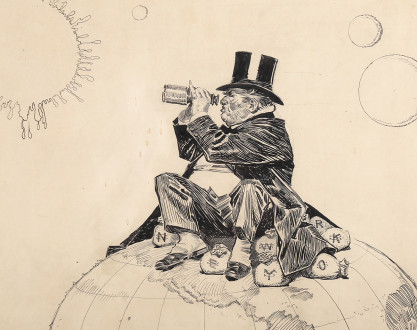


A sharp, scathing political commentary on the heartlessness of tycoons, barons, and monopolists. Depicting a fat cat industrialist sitting on top of the world with his east coast riches dreaming from behind binoculars of otherworldly conquests as he crushes the masses beneath him. A commissioned illustration presumably for an early issue of LIFE magazine, the image captures with wonderful humor the anti-Eastern, trust-busting late Progressive culture of the early 20th century. Work is beautifully framed and matted.

A biography on the artist
Illustrator Orson Lowell, the son of landscapist Milton H. Lowell, was born in 1871. He studied with the well-known anatomist, J. H. Vanderpoel, at the Art Institute of Chicago, Illinois. He moved from Chicago to New York in 1893. Known for the richness of his work in pen and ink, he drew, in 1898, fifty illustrations for The Choir Invisible.
By 1907, he was employed at Life magazine, at that time a humor publication competing with Judge and Punch. He became known for his cartoons with a social message. Lowell was a contemporary of, and often discussed in relation to, the famous illustrator Charles Dana Gibson.
In 1899, F. Marion Crawford published Saracinesca, a two-volume work with one hundred pen and ink drawings and reproductions of paintings by Lowell featuring images of Italian fountains, ancient buildings and bridges.
Lowell illustrated magazines like Life, Judge, The American Girl through the 1940’s. Before the decline of illustrated novels in the early 1920’s, Lowell created illustrations for works little-known today, Love in Old Clothes, 1896; C.N. and A.M. Williamson’s Lady Betty Across the Water, and the works of Charles de Kock.

Orson Byron Lowell died in 1956.
In 2002, Lowell’s work was represented in Toast of the Town: Norman Rockwell and the Artists of New Rochelle, an exhibition of twenty-five artists associated with that New York town, held at the Norman Rockwell Museum, Stockbridge, Massachusetts.
